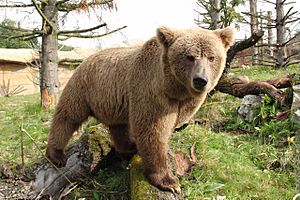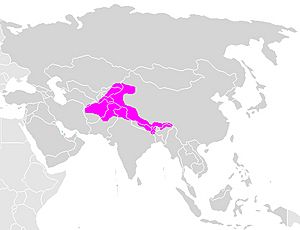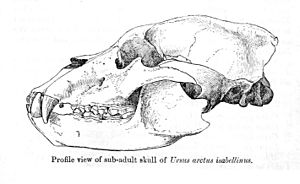Himalayan brown bear facts for kids
Quick facts for kids Himalayan brown bear |
|
|---|---|
 |
|
| Himalayan brown bear | |
| Conservation status | |
| Scientific classification |
|
| Kingdom: | Animalia |
| Phylum: | Chordata |
| Class: | Mammalia |
| Order: | Carnivora |
| Family: | Ursidae |
| Genus: | Ursus |
| Species: | |
| Subspecies: |
U. a. isabellinus
|
| Trinomial name | |
| Ursus arctos isabellinus Horsfield, 1826
|
|
 |
|
| Himalayan brown bear range | |
The Himalayan brown bear (Ursus arctos isabellinus), also known as the Himalayan red bear, isabelline bear or Dzu-Teh, is a subspecies of the brown bear occurring in the western Himalayas. It is the largest mammal in the region, males reaching up to 2.2 m (7 ft 3 in) long, while females are a little smaller. It is omnivorous and hibernates in dens during the winter.
Contents
Description
Himalayan brown bears exhibit sexual dimorphism. Males range from 1.5 to 2.2 m (4 ft 11 in to 7 ft 3 in) long, while females are 1.37 to 1.83 m (4 ft 6 in to 6 ft 0 in) long. They are usually sandy or reddish-brown in colour.
Distribution
The Himalayan brown bear occurs in the western Himalayas from northeastern Pakistan through the Indian states of Jammu and Kashmir, Himachal Pradesh and Uttarakhand to the Himalayas in central Nepal. At present, it is unknown whether the Himalayan brown bear is connected to brown bear populations in the Karakoram Mountains and on the Tibetan Plateau.
Phylogenetics and evolution
The Himalayan brown bear consists of a single clade that is the sister group to all other brown bears and the polar bear. The dating of the branching event, estimated at 658,000 years ago, corresponds to the period of a Middle Pleistocene episode of glaciation on the Tibetan plateau, suggesting that during this Nyanyaxungla glaciation, the lineage that gave rise to the Himalayan brown bear became isolated in a distinct refuge, leading to its divergence.
Phylogenetic analysis has shown that the Gobi bear clusters with the Himalayan brown bear and may represent a relict population of this subspecies.
Behaviour and ecology
The bears go into hibernation around October and emerge during April and May. Hibernation usually occurs in a den or cave made by the bear.
Feeding
Himalayan brown bears are omnivores and will eat grasses, roots and other plants as well as insects and small mammals; they also like fruits and berries. They will also prey on large mammals, including sheep and goats. Adults will eat before sunrise and later during the afternoon.
Threats and conservation
The Himalayan brown bear is poached for fur and claws for ornamental purposes and internal organs for use in medicines. It is killed by shepherds to protect their livestock. In Himachal Pradesh, their home is the Kugti and Tundah wildlife sanctuaries and the tribal Chamba region. The tree bearing the state flower of Himachal, buransh, is the favourite habitat of the Himalayan brown bear. Due to the high value of the buransh tree, it is commercially cut causing further destruction to the brown bear's habitat.
Association with the Yeti
"Dzu-Teh", a Nepalese term, has also been associated with the legend of the Yeti, or Abominable Snowman, with which it has been sometimes confused or mistaken. During the Daily Mail Abominable Snowman Expedition of 1954, Tom Stobart encountered a "Dzu-Teh". This is recounted by Ralph Izzard, the Daily Mail correspondent on the expedition, in his book The Abominable Snowman Adventure. A 2017 analysis of DNA extracted from a mummified animal purporting to represent a Yeti was shown to have been a Himalayan brown bear.
In media
- The 2016 film based on Rudyard Kipling's The Jungle Book portrays Baloo as a Himalayan brown bear.
See also
 In Spanish: Ursus arctos isabellinus para niños
In Spanish: Ursus arctos isabellinus para niños



